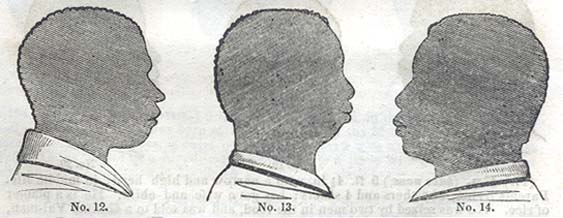The image adorning the cover of Kevin Young’s Ardency intrigued me quite a bit, so I did a bit of digging. It didn’t turn out to be so hard, as the title of the image was on the back cover: A History of the Amistad Captives by John Warner Barber (1840). All across the cover are silhouette profiles of each of the Amistad captives, labelled numerically in order. This immediately reminded me of foolish phrenology posters that would detail certain ‘zones’ on a person’s head that supposedly could indicate intelligence and/or character traits. 
As it turns out, there was a connection between the two. The image of the captives was not only used as physical documentation but the captives’ heads were also measured and analysed phrenologically. For example, one of the image descriptions reads, “Cingue appears to be about 26 years of age, of powerful frame, bilious and sanguine temperament, bilious predominating. His head by measurement is 22 3-8 inches in circumference, 15 inches from the root of the nose to the occipital protuberance over the top of the head, 15 inches from the Meatus Anditorious to do. over the head, and 5 3-4 inches through the head at destructiveness.
The development of the faculties is as follows: Firmness; self-esteem; hope–very large. Benevolence; veneration; conscientiousness; approbativeness; wonder; concentrativeness; inhabitiveness; comparison; form–large…” and continues like that. This text was taken from the book that Barber wrote and illustrated his images for, A History of the Amistad Captives. At the time (1840), phrenology was just beginning to spread to America, and because it was so new no one had been able to truly disprove it, despite how easy it would have been. Phrenology was a ‘science’ based on the fact that the brain designated different parts for different tasks. Physician Franz Joseph Gall proposed the idea of phrenology because of this, and the idea was sustained because of our love of racism. White people used phrenology to justify racism as well as slavery, which is what made me think of the connection between the two above images. It was thought that black people (and other minorities as well) simply were not capable of what white minds were capable of, and they couldn’t help it–they were born that way. This thought surprisingly, though also not, carried on in America until the 1840s when people stopped believing the claims.
Honestly, for me it is tough to look at the cover image thoughtfully. On one hand, they are detailed silhouettes of former slaves and can even be seen as a celebration of their blackness because of the accuracy (especially since the man who made them was trying to help win their case), but on the other hand the portraits were mainly made so they could be judged by a racist ‘science’ with no factual backing whatsoever. I find that to look at both the cover image and the phrenology poster out of their context, they are both beautifully made and can be appreciated as art objectively.
Sources:
http://docsouth.unc.edu/neh/barber/barber.html
http://www.historyofphrenology.org.uk/overview.htm
http://www.victorianweb.org/science/phrenology/intro.html

